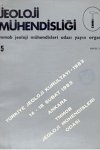
ABSTRACT: Uranium deposits in the Köprübaşı area, Western Turkey occur Im the fluviiitil« sedimentaryrocks, which are uudsuhiin by high grade metamorphlo rocks of the Menderes Massif, These deposits (occur inconglomerates, with abondant eilt and clay matrix and sandstone of coarse clastic Bedlmeötary rocks ofNeagene age. The uranium ore Is present aa matrix Impregnations of uraiiixmi in tabular lenses withinconglomerates and sandstone*. On the basis of their mineralogiical and geochemical oharacteristtcs, they canbe (lividad In to type»; Oxidized and mvDxldlzed, Oxidized deposit can be subdivided In to jarosite-waylanolte richand ilmenite-magiieti`te subtypes`, both of which occur near exposures of uetamorphio basement rocks.Uranium in the lunenlte-magnettte rich subtype is disseminated unUiwmly throughout the sand matrix ofconglomerate whereas it is found in the jarosijte-waylandlte miatture in the jarosrfte-waylandite subtype. Theunoxfdlzed second type contains outhigenlo pyrite and siderite. Vranium in this type is also disseminatedthroughout the clay matrix of fflhe sandstone body. Ore grade uranium concentrations In the unoxWlzed deposit is confined to pyrite-rioh zones, whereas onlylow grade miiicriJi/.ution loeeurs In Blderlte-rlol| zones. Authlgenfcally formed pyrite during and after diiagenesis, which was important la establishtag a favourable geoehemloal environment, was oxidized by movinggroiHufwater resulting In eonsumptton of oxygen inpyriite-rich zones, with consequent formation of aulfiteby pyrtte breakdown. Sulfite, subsequently, disproportionate^ in to HS and SOr The HS generated by thisprocess is believed to have been the major reducing ageng during the formation of this deposit. Althoughthe Jarosite-waylandite-assooiated uraium deposits occur m the oxidized ground, they were apparently derivedfrom oxidation of other unoxidlzed bodies. All the deposits, therefore, are epigeneMo in origin, formed byprecipitation *of uranium by groundwater solution» that moved through host rook. The basement metamorphlcrooks are believed to have been the major source of uranium
ABSTRACT: Hi the first part of this paper, the geological media are classified toto four group» accordingto their ability the bearing of to hold water. In the second part, the aqutfen», whiich are Ute most important groupfrom the soienttflo, technical and economical point, of Tftew, are classified In the frame of the criterionproposed by the author.
ABSTRACT: Fluorite mineralization of Etir Plaine İs located in upper Cretaceous andesltic volcanic rocksin north western, Şebinkarahisar, Giresun. This unit is overlaid by Lutetien volcano . Sedimentary rook»which starts with a basal conglomerate,Fluorite veinlets, up to SO cm. In length, vary between 1-1? cm. tn thtehkness Those »re eoncentratedin three zones trending in. N 10° W _ N 40°W and which have lengthsupto 285 m.In the walls of the veins kaialenlzatlon and some »lUclficatton could be noticable, MJneraloglcal investigations of those veins revealed that the veins were formed in two stages:1, Green fluorite . sphalerite - galena - tennantlte (freiberglte) and ealoopyrite have took place%. link fluorite andyor quartz-purple fluorite have took place.These two stages are seperated from each other by breeelatlon and fragments which belong to first stageare cemented by pink fluorite and purple fluorite.Beside, by working on fluid inclusions of sphalerite and fluorite, homogênlzatlon temperatures of mineralizatiiMi In different stages Is determined, carried out on the samples. The honusgenization tenipeatures ofchanges between ISO0 , 250» O, Absence of halite (NaOI) crystals In the fluid inclusions indicate that salinity Issteady below 80%.
ABSTRACT: The bandet iron formations, which now provide 50 %of the Iron productton in the world areclassified. The geochemistry, metamorphlsm, age«, technology and their relationship to other mineral deposits discus

 TMMOB
TMMOB